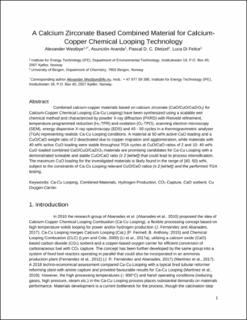| dc.contributor.author | Westbye, Alexander | |
| dc.contributor.author | Sanchez, Maria Asuncion Aranda | |
| dc.contributor.author | Dietzel, Pascal D.C. | |
| dc.contributor.author | Di Felice, Luca | |
| dc.date.accessioned | 2021-06-28T12:26:16Z | |
| dc.date.available | 2021-06-28T12:26:16Z | |
| dc.date.created | 2020-01-20T13:44:31Z | |
| dc.date.issued | 2020 | |
| dc.Published | International Journal of Greenhouse Gas Control. 2020, 95 . | |
| dc.identifier.issn | 1750-5836 | |
| dc.identifier.uri | https://hdl.handle.net/11250/2761662 | |
| dc.description.abstract | Combined calcium-copper materials based on calcium zirconate (CaO/CuO/CaZrO3) for Calcium-Copper Chemical Looping (Ca-Cu Looping) have been synthesized using a scalable wet chemical method and characterized by powder X-ray diffraction (PXRD) with Rietveld refinement, temperature-programmed reduction (H2-TPR) and oxidation (O2-TPO), scanning electron microscopy (SEM), energy dispersive X-ray spectroscopy (EDS) and 45–50 cycles in a thermogravimetric analyser (TGA) representing realistic Ca-Cu Looping conditions. A material at 50 wt% active CuO loading and a CuO/CaO weight ratio of 2 deactivated due to copper migration and agglomeration, while materials with 40 wt% active CuO loading were stable throughout TGA cycles at CuO/CaO ratios of 2 and 10. 40 wt% CuO loaded combined CaO/CuO/CaZrO3 materials are promising candidates for Ca-Cu Looping with a demonstrated tuneable and stable CuO/CaO ratio (≥ 2 [wt/wt]) that could lead to process intensification. The maximum CuO loading for the investigated materials is likely found in the range of [40, 50) wt%, subject to the constraints of Ca-Cu Looping relevant CuO/CaO ratios (≥ 2 [wt/wt]) and the performed TGA testing. | en_US |
| dc.language.iso | eng | en_US |
| dc.publisher | Elsevier | en_US |
| dc.rights | Attribution-NonCommercial-NoDerivatives 4.0 Internasjonal | * |
| dc.rights.uri | http://creativecommons.org/licenses/by-nc-nd/4.0/deed.no | * |
| dc.title | A calcium zirconate based combined material for calcium-copper chemical looping technology | en_US |
| dc.type | Journal article | en_US |
| dc.type | Peer reviewed | en_US |
| dc.description.version | acceptedVersion | en_US |
| dc.rights.holder | Copyright 2020 Elsevier | en_US |
| dc.source.articlenumber | 102953 | en_US |
| cristin.ispublished | true | |
| cristin.fulltext | postprint | |
| cristin.qualitycode | 1 | |
| dc.identifier.doi | 10.1016/j.ijggc.2019.102953 | |
| dc.identifier.cristin | 1777839 | |
| dc.source.journal | International Journal of Greenhouse Gas Control | en_US |
| dc.source.40 | 95 | |
| dc.relation.project | Norges forskningsråd: 254736 | en_US |
| dc.identifier.citation | International Journal of Greenhouse Gas Control. 2020, 95, 102953 | en_US |
| dc.source.volume | 95 | en_US |

